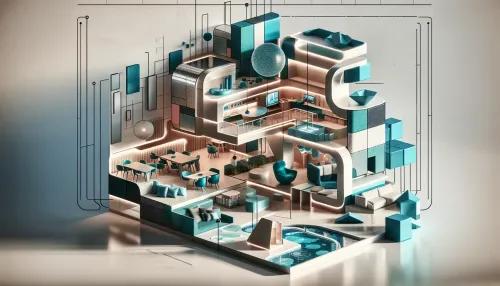
Designing for Inclusion: How Autistic Children are Shaping the Future of Playgrounds

In recent years, there has been a remarkable shift in the way we perceive and design public spaces, particularly playgrounds, to cater to the diverse needs of children. The influence of autistic children has been instrumental in shaping the future of inclusive playgrounds, inspiring innovative designs that prioritize accessibility, sensory integration, and community engagement. In this article, we delve into the world of inclusive playground designs, exploring their impact on the autism community, and shedding light on successful projects and collaborative initiatives that are transforming play spaces worldwide.
Exploring Inclusive Playground Designs Inspired by Needs of Autistic Children
Inclusive playground designs are a result of careful consideration of the unique requirements of all children, including those with autism spectrum disorders. These designs aim to create an environment where children of all abilities can play together harmoniously. Features such as quiet zones, sensory-rich elements, and interactive structures are integrated to ensure that autistic children feel comfortable and engaged while enjoying the playground experience. By understanding the specific needs and preferences of autistic children, playground designers can create spaces that promote social interaction, sensory exploration, and overall well-being.
Understanding Sensory Integration in Public Spaces for Enhanced Accessibility
Sensory integration plays a pivotal role in the design of inclusive playgrounds for autistic children. These spaces are crafted to provide a range of sensory experiences while minimizing potential triggers that could cause distress. Textured surfaces, gentle swings, calming color schemes, and interactive elements are carefully incorporated to create a sensory-friendly environment. By prioritizing sensory integration, these playgrounds foster a welcoming atmosphere where autistic children can engage with their surroundings comfortably, encouraging positive sensory experiences and supporting their developmental needs.
Case Studies: Successful Inclusive Playground Projects Around the Globe
Across the globe, there have been numerous exemplary projects that showcase the successful implementation of inclusive playground designs tailored to the needs of autistic children. From vibrant urban parks to serene suburban play areas, these projects have set new standards for inclusive and accessible play environments. Notable examples include the "Sensory Oasis for Kids" in Australia, the "Snoezelen-Inspired Playground" in the Netherlands, and the "Sensory Garden Playground" in the United States. These case studies highlight the effectiveness of thoughtful design strategies in creating safe and engaging spaces for children with autism and promoting inclusivity within communities.
Architects and Designers Speak: Incorporating Feedback from the Autism Community
The input of architects and designers is crucial in developing inclusive playgrounds that resonate with the needs of autistic children. By actively engaging with members of the autism community, professionals in architecture and design gain valuable insights that inform their creative processes. Through collaborative efforts and participatory design workshops, architects and designers gain a deeper understanding of how to integrate elements that cater to sensory sensitivities, communication challenges, and motor skills development. This inclusive approach ensures that playground designs authentically represent the voices and experiences of autistic individuals.
The Role of Technology in Creating Adaptive Play Environments
Innovations in technology have opened up new possibilities for creating adaptive play environments that seamlessly accommodate the needs of autistic children. Augmented reality games, interactive digital displays, and assistive technology devices contribute to making playgrounds more inclusive and engaging for children on the autism spectrum. By harnessing the power of technology, designers can introduce customizable elements that adapt to individual preferences and support diverse modes of play, further enriching the overall playground experience.
From Concept to Reality: The Journey of Designing an Inclusive Playground
The process of bringing an inclusive playground from concept to reality involves extensive collaboration between various stakeholders from designers and landscape architects to community members and local authorities. It encompasses thorough site assessments, feasibility studies, design iterations, material selection, safety considerations, and adherence to accessibility guidelines. Each phase is guided by a commitment to creating an inclusive space where every child can thrive. Throughout this journey, input from autistic individuals and their families is integral to ensuring that the resulting playground reflects their needs and aspirations.
Funding and Support: How Communities Can Rally for Inclusive Play Spaces
Securing adequate funding and garnering community support are crucial steps in realizing inclusive play spaces for autistic children. Community engagement initiatives, fundraising events, grant applications, and partnerships with non-profit organizations all play a vital role in mobilizing resources for these projects. When communities come together to advocate for inclusive play spaces, they not only contribute to enhancing the quality of life for autistic children but also foster a sense of unity and shared responsibility within their neighborhoods.
The Impact on Families: Stories of Joy and Community Building in Inclusive Playgrounds
The impact of inclusive playgrounds extends beyond providing recreational opportunities for autistic children it fosters a sense of belonging and empowerment within families and communities alike. Through shared experiences at these inclusive play spaces, families forge connections with one another while celebrating diversity and inclusion. Heartwarming stories abound as parents witness their children reveling in moments of joy, friendship, and personal growth within these thoughtfully designed environments.
As we embrace the evolving landscape of inclusive playground designs shaped by the needs of autistic children, it becomes evident that every step taken toward creating more accessible and accommodating public spaces benefits society as a whole. By championing inclusivity through innovative design solutions backed by empathy and understanding, we unveil a future where every child feels welcomed and valued within our communal spaces.


